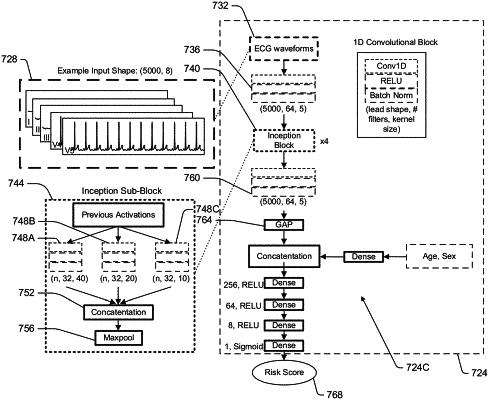| CPC G16H 50/30 (2018.01) [A61B 5/0006 (2013.01); A61B 5/28 (2021.01); A61B 5/318 (2021.01); A61B 5/7275 (2013.01); G16H 50/20 (2018.01); G06F 18/2155 (2023.01)] | 29 Claims |

|
1. A method for determining cardiology disease risk from electrocardiogram trace data and clinical data, comprising:
receiving electrocardiogram trace data associated with a patient;
receiving clinical data associated with the patient;
providing the electrocardiogram trace data and clinical data to a trained machine learning composite model comprising a plurality of clinical outcome prediction layers and a trained composite outcome prediction layer, each layer of the plurality of clinical outcome prediction layers being trained to evaluate the electrocardiogram trace data and the clinical data with respect to a corresponding cardiology disease and generate a cardiology disease risk score, the plurality of clinical outcome prediction layers including a layer for each disease of a set of cardiology diseases comprising three or more of cardiac amyloidosis, aortic stenosis, aortic regurgitation, mitral stenosis, mitral regurgitation, tricuspid regurgitation, abnormal reduced ejection fraction (EF), or abnormal interventricular septal thickness;
providing the cardiology disease risk score for each of the plurality of clinical outcome prediction layers to the trained composite outcome prediction layer; and
generating, by the trained composite outcome prediction layer and based at least in part on each cardiology disease risk score generated by the plurality of clinical outcome prediction layers, a composite risk score reflecting a likelihood of the patient being diagnosed with any cardiology disease of the set of cardiology diseases within a predetermined period of time from when the electrocardiogram trace data was generated; and
outputting the composite risk score to at least one of a memory or a display.
|